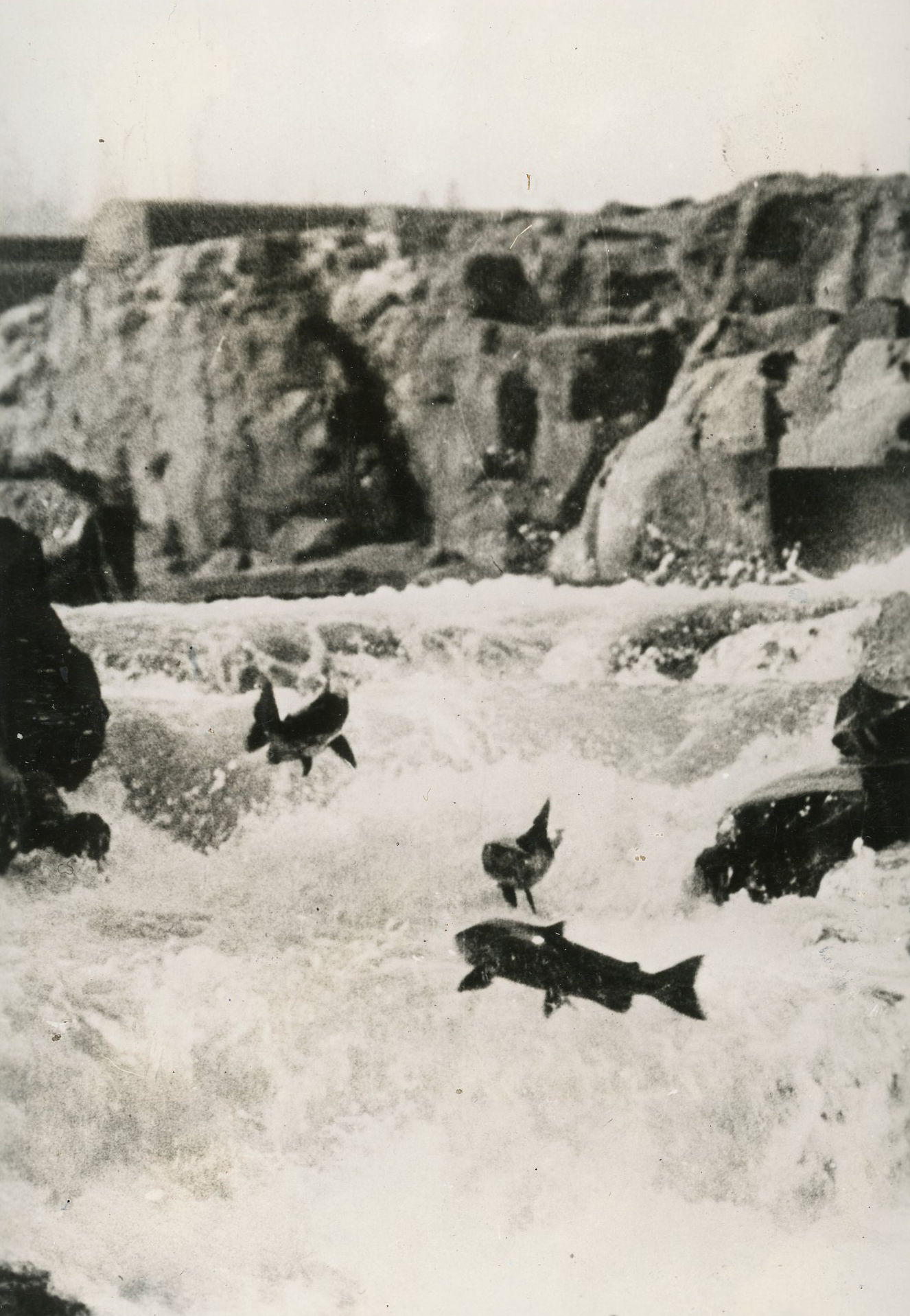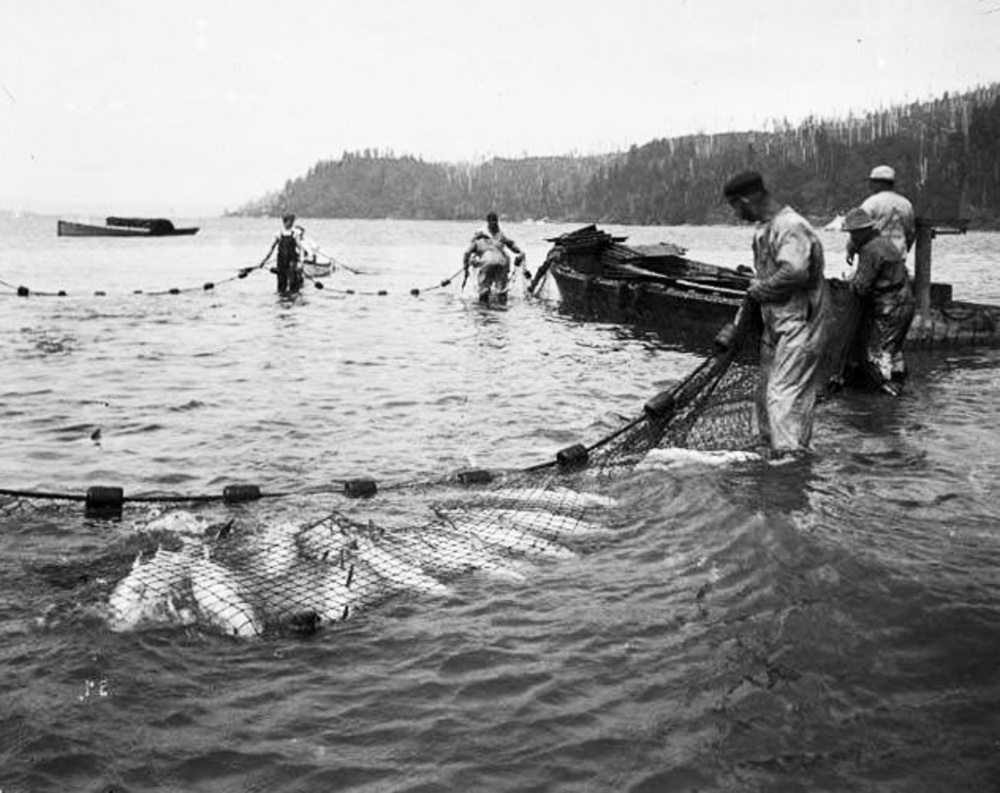A gillnet is used by fishermen throughout the world to catch various species of fish, and scientists frequently use gillnets as a sampling tool to assess fish populations. The nets may be used in salt or fresh water and may be stationary (set net) or mobile (drift net). The Magnuson-Stevens Act (PL 94-265 (1976)), the federal law governing the management of marine fisheries, defines a gillnet as a “panel of netting, suspended vertically in the water by floats along the top and weights along the bottom, to entangle fish that attempt to pass through it." The size of the meshes determines the size of fish caught and enables smaller fish to pass through the openings unharmed.
Gillnets are used throughout the United States, including the East, West, and Gulf coasts; the Great Lakes; on rivers such as the Mississippi and the Columbia; and in Alaska. In Oregon, gillnets have been used historically in a number of coastal rivers. Their use is currently confined to the Columbia River.
On the Columbia, tribal and commercial gillnetters catch shad, smelt, sturgeon, and salmon. Set nets are used only in tribal treaty fisheries, while drift nets are used by treaty tribes and in nontreaty commercial fisheries. Commercial fisheries use a variety of gillnets, including floater nets, which hang from a corkline that floats along the water’s surface; diver nets, which are precisely weighted and buoyed to drift along the river bottom; trammel nets, consisting of two or more walls of webbing of different mesh sizes to catch fish of different sizes; and tangle nets, which have smaller mesh sizes designed to catch fish by their nose or jaw, enabling unwanted bycatch to be resuscitated and released unharmed. Native Americans have used gillnets for millennia on the Columbia River. Traditionally, they knit a web of twine made of natural fiber such as cedar, nettle, or hemp; weighted the nets with stone sinkers; and buoyed them with wooden sticks.
The first non-Native gillnet on the Columbia belonged to Thomas Hodgkins, an immigrant fisherman from the Kennebec River in Maine. He operated the net in 1853 near Oak Point, four miles northwest of present-day Clatskanie. The second belonged to H.N. Rice, who fished at Oak Point, in 1861. He knit the net from twine he spun out of flax purchased locally. In the nineteenth century, fishermen hand-knit web for nets out of linen twine. They hand-molded lead sinkers and made floats of wood. In the twentieth century, other materials, including metal (e.g., aluminum) and plastic, were used to manufacture floats. As technology changed, webs were made from synthetics, such as nylon and polyethylene, and were machine-knit. Astoria is the main center for purchase of web and net supplies, and the majority of Oregon commercial gillnetters live in Clatsop and Columbia counties near their fishing grounds.
A number of initiative petitions were filed during the twentieth and twenty-first centuries in attempts to eliminate gillnets, as well as other forms of commercial fishing gear, from various Oregon waters. Some were successful, such as the ban on traps, seines, and fishwheels; others were not, including initiatives to ban gillnets on the Columbia River. An exception is the ban on gillnetting for steelhead, which does not affect tribal fisheries. Generally, such initiatives represent "competition for resource availability which is fought out with the politics of conservation." Gillnetting is currently the only legal means of providing Columbia River caught fish for sale to consumers in Oregon.
-
![Gillnet diagram.]()
Gillnet, diagram of.
Gillnet diagram. Irene Martin, Legacy and Testament, the Story of Columbia River Gillnetters, p. 134
Related Entries
-
![Columbia River]()
Columbia River
The River For more than ten millennia, the Columbia River has been the…
-
![Salmon]()
Salmon
The word “salmon” originally referred to Atlantic salmon (Salmo salar),…
-
![Seine Fishing]()
Seine Fishing
For much of their fishing history in Oregon, Native Americans used hand…
Related Historical Records
Map This on the Oregon History WayFinder
The Oregon History Wayfinder is an interactive map that identifies significant places, people, and events in Oregon history.
Further Reading
Martin, Irene. A Social Snapshot of the Columbia River Gillnet Fishery. Astoria, Ore.: Salmon For All, 2005.
Martin, Irene. Legacy and Testament, the Story of Columbia River Gillnetters. Pullman: Washington State University Press, 1994. Appendix, pp. 134-138.
Smith, Courtland. Oregon Fish Fights. Corvallis: Oregon State University Press, 1974.
Stewart, Hilary. Indian Fishing: Early Methods on the Northwest Coast. Seattle: University of Washington Press, 1994.




